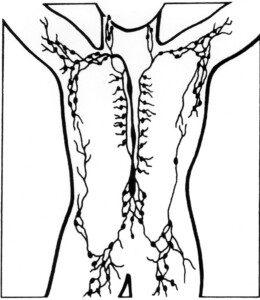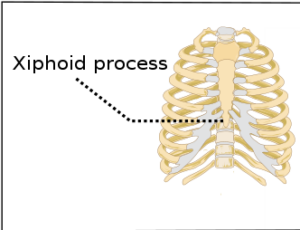It’s not a hernia, so what on earth IS that small, hard lump below your sternum that has no “give” when you press into it?
Cancer can form in soft tissue. You may have quickly discovered this upon googling what the newly-discovered, bean sized lump is that seems to be right below the surface of your skin, seemingly a few inches below the breastbone (sternum) and evenly between the ribs.
It’s fixed in place – not a good sign, you might think. It’s definitely hard, not squishy (and hardness is strongly associated with a malignant mass, while squishiness or softness is associated with benign masses).
Are you able to see the lump when you stand erect in a mirror? If so, this will be more frightening.
In fact, that’s precisely how I discovered the small, hard lump that was located at the uppermost part of my abdomen, a bit below the sternum, and evenly between my ribs.
I was on vacation in a hotel. Only the hall light was on, so when I peered at myself in the bathroom mirror, while standing outside the bathroom, there was a lot of light and dark contrast.
This made it easy for me to notice a vague bulge below my sternum, right at the midline of my upper abdomen.
I thought, What IS that? I then began palpating (feeling) it.
I immediately grew very alarmed. I was pressing on a little lump within the bulge. If I stood normally, I didn’t see the subtle bulge.
But if I stood very erect, with my shoulders back, and a little arch in my back, I’d see the bulge. It was bigger than what the lump felt like.
This made me conclude that the mysterious nodule was close enough to the surface that it was causing the skin around it to raise slightly, creating the “bulge.”
If I was looking down at the area, I couldn’t see bulge. In fact, I couldn’t feel the lump unless I puffed out my chest.
I consulted Google and learned that it maybe, just maybe could be a hernia. But there were features of a hernia that didn’t fit with my new discovery.
I already knew that cancer can develop in soft tissue. These are called soft tissue sarcomas.
Yes, cancer can arise in muscle tissue, for instance. But we don’t hear much about these cancers because they’re uncommon.
There are numerous types of soft tissue cancer.
I took a deep dive to find out if there was any documentation or narrative on cancer arising in the abdominal muscle tissue or, more specifically, the linea alba, the fibrous tissue that vertically runs down the center of the abdomen.
I also did a deep dive on “cancer at the bottom of the sternum.”
I’ll save you a LOT of frightening googling by summarizing my deep dives:
There’s no documented cases of cancer at the bottom of the sternum – though a very rare cancer towards the top of it has been documented.
Searches for “cancer of the top middle of the abdomen,” or similar keyphrasing, will turn up documentation of malignant tumors growing deep inside the abdominal cavity – too deep to be felt with the fingers.
Part of the liver is located kind of between the ribs, below the sternum. Could the lump have been on my liver?
Well, be rest assured that a lump on your liver cannot be felt through the skin.
I then wondered if it could be a swollen lymph node, since we have lymph nodes all throughout our body.
If you google lymph node anatomy or something similar, you’ll be alarmed to see that there’s a “chain” of lymph nodes running vertically down the upper abdomen.

Lymph nodes. Source: National Cancer Institute
However, do not panic, because these lymph nodes are deep and impossible to feel. Even a doctor can’t palpate for them.
The only lymph nodes that you or a doctor can feel are located in the neck, armpits, elbow area and groin. Period.
I then began wondering if the little hard lump might be my xiphoid process, a normal extension of everyone’s sternum.
But I couldn’t locate any content about being able to feel its tip with the fingers. I viewed many images, including postmortem, of the xiphoid process.
I wondered if that was what I was feeling. However, this theory had a few holes.
- I had never noticed the lump before.
- There seemed to be “empty space” between the end of my sternum and the lump!
I ruminated over how I had never felt it before, but had to keep reminding myself that the particular area was just out of range for a breast self-exam.
It was the upper abdomen – I would have never checked there for a breast self-exam. I also had never had any reason to palpate there in my entire life. So maybe it was just a freak chance thing that I had discovered it visually.
So if it was my xiphoid process, how come I wasn’t feeling any of it between the end of my sternum and where the lump began? The empty space felt like abdominal soft tissue.
I could not locate any images of a protruding xiphoid process in an adult, but found two infants for whom it was visible.
The first thing I did when getting home was make an appointment with my primary care physician.
Within 20 seconds of palpating while I was lying down, he said it was “normal anatomy” of my xiphoid process.
I asked about the “empty space” between the end of my sternum and the mysterious hard lump.
His fingers felt there again and he said he could, indeed, feel my xiphoid process there.
Well, I had to take his word for it; HIS fingers were trained to palpate anatomy, not mine.
He said he was 99.9 percent sure it was my xiphoid process, but he’d order an MRI to be 100 percent sure, designating the order as ASAP. This concerned me.
Maybe he was just being empathetic to my worry? I contacted the MRI scheduling department and was told that the soonest opening was three and a half weeks away.
I asked how this could be for an order marked as ASAP. I said, “What if a doctor is very sure that the patient has a very serious condition? Does he indicate ‘very ASAP’ on the order?”
The scheduler said those are marked STAT.
After a few weeks I noticed that I could not bring out a visible bulge in the mirror, but could still feel the lump just the same.
MRI Findings of Small Hard Lump in Middle of Upper Abdomen
The report was sent to me via the email system for the health provider. Under “Impression,” here is the copy-paste.
There is accentuated curvature and mild rotation of the xiphoid process leading to mild prominence of the distal sternum as well as tip of the xiphoid which are both noted in the area percutaneous marking. No adjacent soft tissue mass lesions. No concerning features.
Where it says “HISTORY” is what the doctor put on the order:
Soft tissue mass, chest, superficial; Pt has a bump midline, just inferior to ribs, that seems consistent with normal anatomy based on exam, but getting imaging to be sure. Patient is very worried about a soft tissue mass or cancer, she does not want any radiation from CT scans.
Where it says “SOFT TISSUES”: No definable mass lesions. No abnormal muscle or additional soft tissue anatomy. No concerning features.
This may very well be (actually, I’m pretty darned sure) the only content online about how the tip of the xiphoid process in an adult could protrude enough to be felt with one’s fingers and even seen.

Don’t let that scare you. If you have a seemingly new hard small lump, the size of maybe a bean or pea, in the midline of your upper abdomen – certainly you should not self-diagnose.
But at the same time, you should not lose sleep and obsess over it. What you should do is have a doctor inspect it and then undergo an imaging study.
About 13,000 people in the U.S. are diagnosed with a soft tissue sarcoma (there are dozens of types and they occur all over the body and include children) every year.
 Lorra Garrick has been covering medical, fitness and cybersecurity topics for many years, having written thousands of articles for print magazines and websites, including as a ghostwriter. She’s also a former ACE-certified personal trainer.
Lorra Garrick has been covering medical, fitness and cybersecurity topics for many years, having written thousands of articles for print magazines and websites, including as a ghostwriter. She’s also a former ACE-certified personal trainer.
.



























